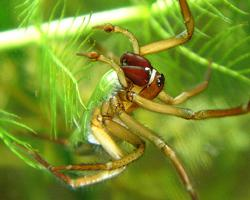
Greutăți și măsuri
| Lungime | de la 8 la 15 mm |
|---|
Starea de conservare
| Neînfricat |
Descrierea animalului
The Diving Bell Spider, scientifically known as Argyroneta aquatica, stands out as a remarkable specimen in the arachnid family due to its unique aquatic lifestyle. Unlike most spiders that are terrestrial, the Diving Bell Spider has adapted to a life submerged in freshwater ponds and slow-moving streams across Europe and parts of Asia. This species exhibits fascinating behaviors and adaptations that enable it to thrive in an underwater environment, making it the only spider known to spend its entire life under water.Physical Description:
The Diving Bell Spider possesses a distinctive appearance that aids in its aquatic lifestyle. It has a relatively small size, with females typically larger than males. The body length of females can reach up to 15mm, while males are usually around 10mm. Their coloration is a muted blend of dark green, brown, or grey, which helps them camouflage with the underwater vegetation and substrates. One of the most notable physical features of Argyroneta aquatica is its abdomen, which is covered with hydrophobic hairs. These hairs trap a layer of air, giving the abdomen a silvery sheen when submerged and serving a crucial role in the spider's underwater breathing mechanism.
Habitat and Distribution:
Argyroneta aquatica is predominantly found in clean, freshwater habitats such as ponds, marshes, and slow-moving streams. These environments provide the necessary conditions for the spider's unique lifestyle, including an abundance of aquatic vegetation and prey. The species is distributed across Europe and extends into parts of Asia, with populations adapting to various local conditions within these freshwater ecosystems.
Behavior and Ecology:
One of the most extraordinary behaviors of the Diving Bell Spider is its construction of underwater silk webs, known as diving bells, which serve multiple purposes including as a residence, a mating chamber, and a nursery for its eggs. The spider constructs these bells by spinning silk between aquatic plants and then filling the web with air collected from the surface. The diving bell acts as a physical gill, allowing dissolved oxygen from the water to replenish the air supply within the bell, while carbon dioxide diffuses out into the water.
The Diving Bell Spider is a proficient hunter, preying on aquatic insects, larvae, and even small fish. It uses its silk bell as a base from which it can launch surprise attacks on unsuspecting prey. Its hydrophobic hairs and air bubble enable it to move swiftly through the water while remaining submerged.
Reproduction:
The reproductive process of Argyroneta aquatica involves the male spider courting the female within her diving bell. After mating, the female lays her eggs within the bell, where she guards them until they hatch. The diving bell provides a safe, oxygen-rich environment for the developing eggs and newly hatched spiderlings.
Conservation:
While not currently listed as endangered, the Diving Bell Spider's reliance on clean, unpolluted water makes it vulnerable to habitat degradation, pollution, and changes in water quality. Conservation efforts are essential to preserve the freshwater habitats that this unique spider calls home.
In conclusion, the Diving Bell Spider, Argyroneta aquatica, is a fascinating example of adaptation and survival in an aquatic environment. Its unique lifestyle, behaviors, and the intricate diving bells it constructs set it apart from other spider species, offering valuable insights into the diversity and adaptability of life on Earth.
Fotografii noi cu animale
Top 10 animale
- Dolphin gull (Leucophaeus scoresbii)
- Diana monkey (Cercopithecus diana)
- Moustached guenon (Cercopithecus cephus)
- Galápagos tortoise (Geochelone nigra complex)
- Japanese macaque (Macaca fuscata)
- Stone loach (Barbatula barbatula)
- Russian tortoise (Testudo horsfieldii)
- Greek tortoise (Testudo graeca)
- Common flying dragon (Draco volans)
- Vendace (Coregonus albula)